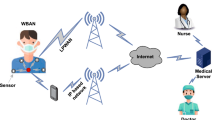Abstract
As the wireless world is rapidly evolving towards the “Beyond the 3rd Generation” (B3G) era, communication infrastructures need to tackle external conditions that are continuously changing, and thus become less predictable in terms of quality of service (QoS) provision. On the contrary, the B3G era, through the coexistence and complementary use of a multitude of Radio Access Technologies (RATs), offers additional capabilities for providing users with advanced levels of convenience and flexibility for living and working. Those advances in communications and networking technology are making it possible to devise ‘ambient’ systems, i.e. systems that realize the vision of an all-encompassing multimedia networking environment, which is aware of the users’ presence and context, and is sensitive, adaptive, and responsive to their needs, habits, gestures and emotions. All above pose significant challenges regarding the intelligent management of heterogeneous wireless infrastructures. In the light of the above, this paper presents such an advanced management framework, as an enabling technology for designing and developing ambient, wireless systems in B3G environments. The paper focuses on the main components of the proposed framework, as well as on their functionality and interactions. Additionally, indicative simulation results showcase the efficiency of the proposed framework.






Similar content being viewed by others
References
Third (3rd) Generation Partnership Project (3GPP). Web site, www.3gpp.org, 2007
Institute of Electrical and Electronics Engineers (IEEE). www.ieee802.org, 2007
Digital Video Broadcasting (DVB). Website, www.dvb.org, 2007
IST-2005-027714 End-to-End Reconfigurability (E2R II) Project. http://www.e2r2.motlabs.com, 2007
Varshney U, Malloy AD (2001) Improving the dependability of wireless networks using design techniques. Local Computer Networks, 2001. Proceedings. LCN 2001. 26th Annual IEEE Conference on, vol., no., 122–131
Basile C, Killijian M-O, Powell D (2003) A survey of dependability issues in mobile wireless networks. Technical report, Laboratory for Analysis and Architecture of Systems, National Center for Scientific Research, Toulouse, France, Feb 2003
Demestichas P, Vivier G, Martinez G, Papadopoulou L, Stavroulaki V, Galliano F et al (2002) Wireless beyond 3G: managing services and network resources. IEEE Computer 35(8):96–98
Niebert N, Schieder A, Zander J, Hancock R (eds) (2007) Ambient networks: co-operative mobile networking for the wireless world. Wiley, New York
Aarts E, Harwig R, Schuurmans M (2001) Ambient intelligence. In Denning PJ (ed) The invisible future: the seamless integration of technology into everyday life. McGraw-Hill, New York, NY, pp 235–250
Aarts E, Marzano S (eds) (2003) The new everyday: visions of ambient intelligence. 010, Rotterdam, The Netherlands
Aarts E (2004) Ambient intelligence: a multimedia perspective. IEEE MultiMedia 11(1):12–19 doi:10.1109/MMUL.2004.1261101
Riva G, Vatalaro F, Davide F, Alcañiz M (eds) (2005) Ambient Intelligence. IOS, Amsterdam
Weiser M (1991) The computer for the twenty-first century. Scientific American 265(3):94–104 the father of ubiquitous computing
Brunner M, Gunnar A, Abrahamsoson H et al (2004) Ambient Networks Management Challenges and Approaches. Lecture Notes in Computer Science, Book chapter in Mobility Aware Technologies and Applications 3284:196–216
Gellersen H-W, Schmidt A, Beigl M (2000) Adding some smartness to devices and everyday things. Proceedings of IEEE Workshop on Mobile Computing Systems and Applications 2000 (WMCSA ‘00), Dec. 2000, Monterey, USA, IEEE Press
ITEA Ambience Project. (000003). Available online at http://www.hitech-projects.com/euprojects/ambience/
Satyanarayanan M (2001) Pervasive computing: vision and challenges. IEEE Personal Communication 8(4):10–17 Aug
Tsagkaris K, Dimitrakopoulos G, Saatsakis A, Demestichas P (2007) Distributed radio access technology selection for adaptive networks in high-speed, B3G infrastructures. International Journal of Communications Systems, Wiley 20(8):969–992 Aug
Stavroulaki V, Buljore S, Roux P, Mélin E (2006) Equipment management issues in B3G, end-to-end reconfigurable systems. IEEE Wireless Communications Magazine, Special issue on Composite Reconfigurable Radio Networks 12(3):24–32 June
Stavroulaki V, Katidiotis A, Petromanolakis D, Demestichas P (2006) Equipment Management Strategies in Reconfigurable Networks. In Proc. 63rd IEEE Vehicular Technology Conference (VTC-06 Spring), Melbourne, Australia, May 2006
IEEE P1900.4. http://grouper.ieee.org/groups/emc/emc/1900/4/
Buljore S et al (2007) Introduction to IEEE P1900.4 Activities. IEICE Transactions on Communications, Special Section on Cognitive Radio and Spectrum Sharing Technology (Invited Paper) E91-B:2–9, Jan. 2007
Tsagkaris K, Dimitrakopoulos G, Demestichas P (2008) Policies for the reconfiguration of cognitive wireless infrastructures to 3G Radio Access Technologies. ACM/Springer Wireless Networks (in press)
Kulkarni G, Adlakha S, Srivastava M (2005) Subcarrier allocation and bit loading algorithms for OFDMA-based wireless networks. IEEE Transactions on Mobile Computing 4(6):652–662 doi:10.1109/TMC.2005.90
Klemperer P (2004) Auctions: Theory and Practice. Princeton University Press
Auction (2008, May 8). In Wikipedia, The Free Encyclopedia. Retrieved 10:31, May 9, 2008,from: http://en.wikipedia.org/w/index.php?title= Auction and oldid = 211117120
Jennings NR, Faratin P, Lomuscio AR, Parsons S, Sierra C, Wooldridge M (2001) 2001 automated negotiation: prospects, methods and challenges. Int J of Group Decision and Negotiation 10(2):199–215 doi:10.1023/A:1008746126376
Acknowledgements
This work has been performed in the framework of the European funded project End-to-end Reconfigurability-2nd phase (E2R II). The project has received research funding from the Community’s Sixth Framework program. The authors would like to acknowledge the contributions of their colleagues from the E2R II consortium. The views expressed in this document do not necessarily represent the views from the complete E2R II consortium. The Community is not liable for any use that may be made of the information contained therein.
In part this work shall continue in the framework of the European funded project End-to-end Efficiency (E3), funded from the Community’s Seventh Framework program.
Author information
Authors and Affiliations
Corresponding author
Rights and permissions
About this article
Cite this article
Dimitrakopoulos, G., Tsagkaris, K., Stavroulaki, V. et al. A Management Framework for Ambient Systems Operating in Wireless B3G Environments. Mobile Netw Appl 13, 555–568 (2008). https://doi.org/10.1007/s11036-008-0090-0
Received:
Accepted:
Published:
Issue Date:
DOI: https://doi.org/10.1007/s11036-008-0090-0




